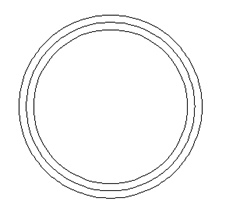We approximate the role as a series of concentric circles. For simplicity, our diagram contains exactly two “wraps” of tape. Note that it takes the first two circles just to obtain the first wrap since we are considering it’s thickness – sort of. From thereon, the outside of the ith wrap is the inside of the (i+1)th wrap. Although we are making some consideration for the thickness, we are only intending to apply our results to cases were the thickness is very small. In particular, we assume that the place where the next wrap begins to overlap the previous wrap does not cause the shape of the wrap to significantly deviate from that of a circle.

We observe that the number of wraps n is given by the difference of the inner and outer radii divided by the thickness of a single wrap of tape:
\[n=\frac{r_n - r_0}{\tau}\]
We further note that the radius of the ith wrap is given by ri = r0 + τi and so the circumference of the ith wrap is given by Ci = 2π(r0 + τi) = 2πr0 + 2πτi. So the total length of the tape (L) is given thus:
\[ = \sum_{i=1}^n{2 \pi r_0} + \sum_{i=1}^n{2 \pi \tau i}\]
\[ = 2 \pi r_0 n + 2 \pi \tau \sum_{i=1}^n{i}\]
\[ = 2 \pi r_0 n + 2 \pi \tau n (n+1)/2\]
\[ = 2 \pi r_0 n + \pi \tau n (n+1)\]
By substituting the equation for n into the equation for L we can relate the thickness, τ, to the length and inner and outer radius:
\[L = 2 \pi n r_0 + \pi \tau n (n+1)\]
\[L = 2 \pi ({{r_n - r_0}\over{\tau}})r_0 + \pi \tau (\frac{r_n - r_0}{\tau})(\frac{r_n - r_0}{\tau}+1)\]
\[\tau L = 2 \pi (r_n - r_0)r_0 + \pi (r_n - r_0)(r_n - r_0 + \tau)\]
\[\tau L = 2 \pi (r_n - r_0)r_0 + \pi (r_n - r_0)(r_n - r_0) + \pi (r_n - r_0) \tau\]
\[\tau L - \pi (r_n - r_0) \tau = 2 \pi (r_n - r_0)r_0 + \pi (r_n - r_0)^2\]
\[(L - \pi (r_n - r_0)) \tau = 2 \pi (r_n - r_0)r_0 + \pi (r_n - r_0)^2\]
\[\tau = \frac{\pi (r_n - r_0)(2 r_0 + r_n - r_0)}{L - \pi (r_n - r_0)}\]
\[\tau = \frac{\pi (r_n - r_0)(r_n + r_0)}{L - \pi (r_n - r_0)}\]
Now that we have τ in terms of known values, our equation for n can be used to determine the number of wraps. What is it good for? I have no idea, but if you want to know how thick your masking tape is and how many wraps, you could apply these formulae. The manufacturer will give you a total length and you can supply the rest by taking measurements. Your results will be pretty approximate and pointless of course. (I'm sure there are real world applications, just none that I'm involved in.)